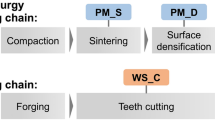Abstract
In gear production, resource efficiency considering material, energy and time can be achieved using a powder metallurgical process chain. Furthermore, powder metallurgical gears have a lower weight, which will improve the fuel efficiency of a gear box as well. Currently powder metallurgical gears are not used in series-production automobile gear boxes. The main reason for this is a lower expected tooth root fatigue strength, which can be increased using surface densification by rolling. The investigation of how the powder metallurgical (PM) gear manufacturing has to improve in order to gain the possible resource efficiency, is funded in the Priority Program "Resource efficient machine elements”. This paper considers a two-step approach to increase the tooth root fatigue strength of PM gears. The first step is to calculate the fatigue strength considering the density profile of the gear. This first step will result in a description of the optimal density profile. The second step is an investigation of how the density profile and the manufacturing properties can be influenced using different process designs. This step will result in a guideline to change the density profile to the one described in the first step. The combined knowledge of which density profile is necessary and how it can be achieved will give the chance to increase the tooth root fatigue strength of powder metallurgical gears. This paper considers the first part of both steps of the approach.















Similar content being viewed by others
References
Behrens BA, Gastan E, Vahed N, Lange F (2010) Numerical analysis of the process chain for the production of PM components with integrated information storage. Prod Eng 4(5):477–482
Beiss P (2003) Mechanische Eigenschaften von Sinterstählen
Beiss P (2013) Pulvermetallurgische Fertigungstechnik. Springer Vieweg
Beiss P, Zafari ALKBJ (2012) Fatigue behavior of a sintered steel containing 4 % Ni, 1.5 % Cu, 0.5 % Mo and 0.6 % C. Int J Powder Metal 48:19–34
DIN (1987) Begriffe und Bestimmungsgrößen für Stirnräder (Zylinderräder) und Stirnradpaare (Zylinderradpaare) mit Evolventenverzahnung
Doege E, Behrens BA (2007) Handbuch Umformtechnik: Grundlagen, Technologien, Maschinen; mit 55 Tabellen. Springer, Berlin
Felten K (2008) Verzahntechnik: Das aktuelle Grundwissen über Herstellung und Prüfung von Zahnrädern, 2nd edn. Expert-Verl, Renningen
Fereshteh-Saniee F, Pillinger I, Hartley P (2004) Friction modelling for the physical simulation of the bulk metal forming processes
Kauffmann P (2013) Walzen pulvermetallurgisch hergestellter Zahnräder. Ph.D. thesis, Rheinisch-Westfälische Technische Hochschule, Aachen
Klocke F, König W (2005) Fertigungsverfahren: Umformen. Springer, Berlin
Klocke F, Gorgels C, Gräser E (2011) Study of tool design for surface densification of PM Gears
Kotthoff G (2003) Neue Verfahren zur Tragfähigkeitssteigerung von gesinterten Zahnrädern. Ph.D. thesis, Rheinisch-Westfälische Technische Hochschule, Aachen
Neumaier T (2003) Zur Optimierung der Verfahrensauswahl von Kalt-, Halbwarm- und Warmmassivumformverfahren. Ph.D. thesis, Universität, Hannover
Neugebauer R, Klug D, Hellfritzsch U (2007) Description of the interactions during gear rolling as a basis for a method for the prognosis of the attainable quality parameters
Strehl R (1997) Tragfähigkeit von Zahnrädern aus hochfestem Sinterstählen. Ph.D. thesis, Rheinisch-Westfälische Technische Hochschule, Aachen
Strehl R (2012) Wirtschaftlichkeit von P/M-Verzahnungen. In Tagungsband zu: Aktuelle Entwicklungen beim Vorverzahnen 2012
Tiedemann I, Hirt G, Kopp R, Michl D, Khanjari N (2007) Material flow determination for radial flexible profile ring rolling. Prod Eng 1(3):227–232
Wimmer AJ (2006) Lastverluste von Stirnradverzahnungen: Konstruktive Einflüsse, Wirkungsgradmaximierung, Tribologie, FZG / FZG, Lehrstuhl für Maschinenelemente, Forschungsstelle für Zahnräder und Getriebebau, vol 152. Shaker, Aachen
Zafari A, Beiss PBCLK (2011) Assessing the fatigue strength of a sintered steel as affected by the highly stressed volume. pp 15–20. EPMA, Shrewsbury
Acknowledgments
This work is funded as the project “High-strength gears by powder metallurgical manufacturing processes” which is part of the Priority Program “Resource efficient machine elements” (SPP 1551) by the German Research Foundation (DFG). We thank GKN Sinter Metals for sintering and the institute “Werkstoffsynthese und Herstellungsverfahren (IEK-1)” of Forschungszentrum Jülich for hot isostatic pressing the fatigue specimen.
Author information
Authors and Affiliations
Corresponding author
Rights and permissions
About this article
Cite this article
Gräser, E., Hajeck, M., Bezold, A. et al. Optimized density profiles for powder metallurgical gears. Prod. Eng. Res. Devel. 8, 461–468 (2014). https://doi.org/10.1007/s11740-014-0543-1
Received:
Accepted:
Published:
Issue Date:
DOI: https://doi.org/10.1007/s11740-014-0543-1




